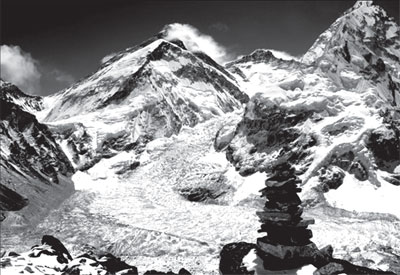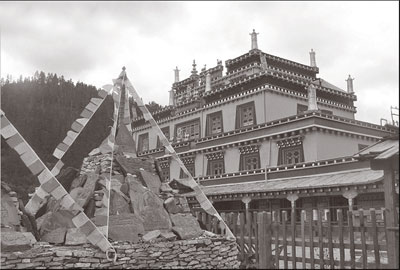Peaceful development of China's Tibet
R. Jinith de Silva
Chinese Tibet is known as the 'Roof of the world'. The average height
of the country is over 15,000 feet. From the days immemorial, Tibet has
been a part of China, from the time of emperor Yuan in 1279. Whole of
Tibet was under Chinese rule by the beginning of the 20th century. The
British imperialists entered Tibet and tried to distance it from China.
|

Chinese Tibet is known as the ‘Roof of the world’ |
They received the fullest co-operation of the aristocracy and Lamas
for this sinister scheme. They wanted to create a division between China
and Tibet so that an independent state could be created thus weakening
China. Before the British got involved in the affairs of Tibet there was
no equivalent word in the Tibetan language for independence.
The main object of this article is to depict how Tibet advanced in
every field after it was liberated from the yoke of Lamas and the
aristocrats and brought under the control of the central government in
Beijing.
Prior to 1959 the government in control of Tibet was aristocratic.
The ordinary people who were peasants and nomads did not own 95 percent
of the land. All the arable land was owned by Lamas and aristocrats who
comprised 5 percent of the population. The ordinary people were surfs
and the system that existed in Tibet could be termed as semi-slavery. It
was said that ordinary people owned nothing but their shadows and
footprints. These enslaved people received their political, religious,
economic, social and cultural freedom after 1959. They obtained the same
freedom enjoyed by the people of other provinces of China.
Political freedom
After 1959 millions of former serf become masters of their society
and destiny. Tibet changed from an autocracy to a democracy. Tibet
become a autonomous region under the umbrella of the central government.
The administration of the region was done by the Tibetans themselves.
The chairperson of the People's Congress was a Tibetan and women too
received voting rights.
The people of Tibet obtained full economic freedom after 1959. Ninety
five percent of the population who were peasants and nomads received the
freedom they needed to till and graze animals on the lands and receive
the income of those lands. As a result their incomes started to rise
since 1959.
People who were deprived of having a square meal managed to fill
their belles with this change. The gross domestic product which was 174
M Yuan reached 50.74 B Yuan by 2010. The per capita income which was 144
Yuan in 1959 reached 15,000 Yuan in 2010.
The central government obtained assistance from other provinces to
develop Tibet. A certain percentage of the revenue of other provinces
was diverted for the development of Tibet. The centre was keen on
creating economic parity in Tibet comparing to other provinces.
The partnership assistance programme started in 1994 and fifteen
other provinces have helped Tibet to initiate 62 new projects.
Agriculture
With the freedom they received in their land the peasants of Tibet,
diversified their crops, they cultivated. The grain production on which
was 182,000 tons in 1951 reached a staggering 1,100,000 tons in 2010.
The annual paddy production of one Mu in 1959 was 91 Kgs. The peasants
managed to increase it to 400 kgs in 2010. The number of animals under
the nomads and peasants in 1959 was 9.56 million and it increased to 26
million in 2010.
There were no industries in Tibet prior to 1959. Some people started
industries with the direction provided by the central government. After
1959 generation of electricity, mining textile, cottage industries and
some medium sized industries started in Tibet. Fruits of opening the
economy in 1978 brought many benefits to Tibet. Comparing to the
provinces, Tibet holds the second position in the production of copper.
Tibetan beer produced from barley is famous today. The industrial added
value skyrocketed from 1.5 M Yuan to 3,500m, in 1910.
|

Tibetan culture village Xiagei. Pic. courtesy: Google |
Foreign trade
In 2004, the value of foreign trade was US $ 22.355 million and it
increased to US $ 835.94 million in 2010. Tibetan products are exported
to countries like India, Nepal, Japan, Korea, Singapore, Hong Kong and
America.
A good road network is a basic necessity for economic development.
Prior to 1984 all the roads of Tibet were in a ramshackled state. People
who lived in remote areas had to carry their products on their shoulders
or on the back of animals, when transporting them to markets sometimes
miles away. It was indeed a miserable existence.
A reporter of China daily who travelled from Beijing to Lhasa in 1959
had spent 21 days travelling. The central government which understood
this drawback started constructing new roads with the concurrence of the
provincial government all over Tibet from 1959. Today new roads are
constructed from Lhasa to very remote areas such as Metog. The first
expressway was started in 2009, from Lhasa to Gonggar airport. By 2006,
the central government managed to link Lhasa to Beijing railway reducing
the travel time between the two cities to 24 hours. Before 1959 the
traveling time was 21 days.
As a result Tibet managed to send its exports to other provinces as
well as to the world market in double quick time. New airports not only
in Lhasa but also in Nuingahinao, Ngari and Xigwge, paved way for rapid
development in remote areas. There were only 7,300 km of highways in
Tibet and by 2010 it increased to 58,200 kms.
New houses
Prior to 1959 most of the peasants lived in mud huts along with their
livestock. After 1959 the central government along with provincial
administration launched a programme to improve the housing standards of
these peasants. By 2006 they managed to provide decent housing to about
1.4 m ordinary people, spending RMB 1.7 billion. The name of this was
'Safe and Cozy' with amenities such as electricity running water paved
roads, post officers, telephones and facilities for TV and radio
reception. Electricity was provided to 740,000 persons and drinking
water was provided to 952,000 people. The coverage of telephone and
TV/radio signals now stands at 90.28 percent and 91.41 percent
respectively and 135,000 rural households are new cooking with biogas.
Prior to 1959 only 2 percent of the children of pre-school age
attended school. Illiteracy rate was 95 percent.
Today the illiteracy rate has come down to 1.2 percent. Today the
education is provided free of charge. In other provinces of China a fee
is charged for education.
Financial assistance granted to village students in Tibet was
increased to 2000 Yuan in 2011.
First university was started in 1984 and today several universities
are found in Tibet. Medical College of Tibet was started in 1989. There
are more than 100 PhD holders in Tibet and Tibetan botanist Nunyuna
Zhovna is one of the ten leading women scientists of China.
Tibetans are free to follow any religion they wish. This has been
accepted by the regional administration as well. There are about 1,700
Buddhist temples and monasteries and over 40,000 Buddhist monks in Tibet
today. Huge sums are spent by the central government and the provincial
administration to preserve Buddhism, to develop Buddhist places of
worship, to preserve Buddhist books and manuscripts and for the
restoration of the Buddhist temples.
Living standard
Under the new administration the living standards of the Tibetan
people have gone up tremendously. Tibetans who led a miserable existence
in past lead somewhat a better life like most of other people of China
today.
The people who used dung cakes for cooking purposes today use L.P.
gas. Some own motor vehicles and most of the people use small comforts
like television and cellular phones.
As life has become somewhat comfortable the population has increased
from 1.23 million in 1959 to 30 million today. Life expectancy of
average in Tibetan is 69 today. Sixty years ago it was 35.5 years.
Some Tibetan separatists who have escaped to India spread canards
with the assistance of some Western media agencies that genocide is
being conducted by China to decimate the population of Tibet. But in
reality Tibet that was backward in every sphere before 1959 is advancing
at an unprecedented growth rate like the rest of China.
The writer is the Secretary of Sri Lanka - China Society |



